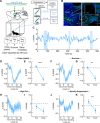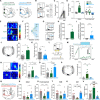Extended amygdala-parabrachial circuits alter threat assessment and regulate feeding
- PMID: 33637526
- PMCID: PMC7909877
- DOI: 10.1126/sciadv.abd3666
Extended amygdala-parabrachial circuits alter threat assessment and regulate feeding
Abstract
An animal's evolutionary success depends on the ability to seek and consume foods while avoiding environmental threats. However, how evolutionarily conserved threat detection circuits modulate feeding is unknown. In mammals, feeding and threat assessment are strongly influenced by the parabrachial nucleus (PBN), a structure that responds to threats and inhibits feeding. Here, we report that the PBN receives dense inputs from two discrete neuronal populations in the bed nucleus of the stria terminalis (BNST), an extended amygdala structure that encodes affective information. Using a series of complementary approaches, we identify opposing BNST-PBN circuits that modulate neuropeptide-expressing PBN neurons to control feeding and affective states. These previously unrecognized neural circuits thus serve as potential nodes of neural circuitry critical for the integration of threat information with the intrinsic drive to feed.
Copyright © 2021 The Authors, some rights reserved; exclusive licensee American Association for the Advancement of Science. No claim to original U.S. Government Works. Distributed under a Creative Commons Attribution NonCommercial License 4.0 (CC BY-NC).
Figures







Similar articles
-
Efferent projection from the bed nucleus of the stria terminalis suppresses activity of taste-responsive neurons in the hamster parabrachial nuclei.Am J Physiol Regul Integr Comp Physiol. 2006 Oct;291(4):R914-26. doi: 10.1152/ajpregu.00750.2005. Am J Physiol Regul Integr Comp Physiol. 2006. PMID: 16966389
-
α(2A)-adrenergic receptors filter parabrachial inputs to the bed nucleus of the stria terminalis.J Neurosci. 2014 Jul 9;34(28):9319-31. doi: 10.1523/JNEUROSCI.0822-14.2014. J Neurosci. 2014. PMID: 25009265 Free PMC article.
-
BNST transient activity associates with approach behavior in a stressful environment and is modulated by the parabrachial nucleus.Neurobiol Stress. 2020 Aug 1;13:100247. doi: 10.1016/j.ynstr.2020.100247. eCollection 2020 Nov. Neurobiol Stress. 2020. PMID: 33344702 Free PMC article.
-
Chemoarchitecture of the bed nucleus of the stria terminalis: Neurophenotypic diversity and function.Handb Clin Neurol. 2021;179:385-402. doi: 10.1016/B978-0-12-819975-6.00025-X. Handb Clin Neurol. 2021. PMID: 34225977 Free PMC article. Review.
-
Optogenetic strategies to investigate neural circuitry engaged by stress.Behav Brain Res. 2013 Oct 15;255:19-25. doi: 10.1016/j.bbr.2013.05.007. Epub 2013 May 16. Behav Brain Res. 2013. PMID: 23684554 Free PMC article. Review.
Cited by
-
Activation of Parabrachial Tachykinin 1 Neurons Counteracts Some Behaviors Mediated by Parabrachial Calcitonin Gene-related Peptide Neurons.Neuroscience. 2023 May 1;517:105-116. doi: 10.1016/j.neuroscience.2023.03.003. Epub 2023 Mar 9. Neuroscience. 2023. PMID: 36898496 Free PMC article.
-
GABAergic CaMKIIα+ Amygdala Output Attenuates Pain and Modulates Emotional-Motivational Behavior via Parabrachial Inhibition.J Neurosci. 2022 Jul 6;42(27):5373-5388. doi: 10.1523/JNEUROSCI.2067-21.2022. Epub 2022 Jun 6. J Neurosci. 2022. PMID: 35667849 Free PMC article.
-
Glutamatergic supramammillary nucleus neurons respond to threatening stressors and promote active coping.Elife. 2024 Jun 3;12:RP90972. doi: 10.7554/eLife.90972. Elife. 2024. PMID: 38829200 Free PMC article.
-
Functional Dissection of Glutamatergic and GABAergic Neurons in the Bed Nucleus of the Stria Terminalis.Mol Cells. 2021 Feb 28;44(2):63-67. doi: 10.14348/molcells.2021.0006. Mol Cells. 2021. PMID: 33594012 Free PMC article. Review.
-
Convergence of monosynaptic inputs from neurons in the brainstem and forebrain on parabrachial neurons that project to the paraventricular nucleus of the thalamus.Brain Struct Funct. 2022 Sep;227(7):2409-2437. doi: 10.1007/s00429-022-02534-6. Epub 2022 Jul 15. Brain Struct Funct. 2022. PMID: 35838792 Free PMC article.
References
Publication types
Grants and funding
- T32 GM008151/GM/NIGMS NIH HHS/United States
- F30 MH116654/MH/NIMH NIH HHS/United States
- T32 DA007278/DA/NIDA NIH HHS/United States
- UL1 RR024992/RR/NCRR NIH HHS/United States
- R56 NS048602/NS/NINDS NIH HHS/United States
- R01 NS106953/NS/NINDS NIH HHS/United States
- UL1 TR002345/TR/NCATS NIH HHS/United States
- R01 DA033396/DA/NIDA NIH HHS/United States
- P30 DA048736/DA/NIDA NIH HHS/United States
- U01 MH109133/MH/NIMH NIH HHS/United States
- R01 MH112355/MH/NIMH NIH HHS/United States
- F31 DA051124/DA/NIDA NIH HHS/United States
- F31 MH122033/MH/NIMH NIH HHS/United States
LinkOut - more resources
Full Text Sources
Other Literature Sources
Molecular Biology Databases

